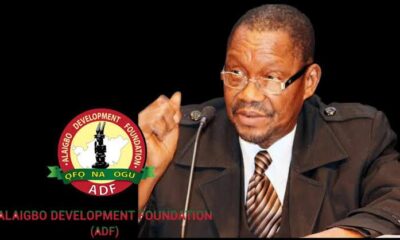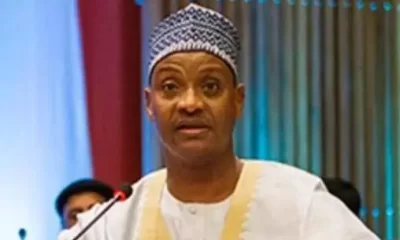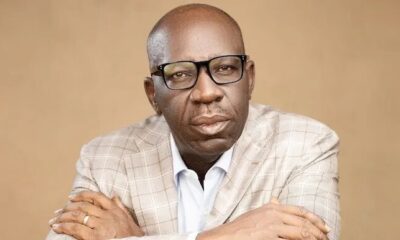Economic Issues
Still On The Naira’s Exchange Rate -By Uddin Ifeanyi

At current levels of consumption, our foreign reserves barely support five months of imports. Nor have the fiat measures it has implemented thus far done much but distort the functioning of the price mechanism, and move an already opaque process into rooms filled with smoke, mirrors, and thaumaturgy.
Following reports, late Thursday afternoon, last week, that the Central Bank of Nigeria (CBN) had called a hush-hush meeting “with banking executives and currency dealers” (which was how Bloomberg News reported it), I spent all of the weekend looking for confirmation that the meeting held. Of far more importance, though, was the need to understand what was agreed by the meeting on how to handle existing restrictions on foreign exchange trading.
As the bottom fell out of the global oil market last year, and the country found it increasingly hard to push the crude oil volumes we were accustomed to onto the markets, or sell for the premium that our sweet light crude once commanded, pressure built up on the naira. Part of this pressure on the national currency was understandably speculative. A few market participants could not have helped notice that our managed float always presumed that the central bank would have enough dollar balances to meet domestic demand at the subsidised rates on offer. Nor could this same group have refrained from taking a one-way bet on the naira’s outlook once it was clear that the pot from which the CBN managed the float was emptying rapidly.
It mattered, therefore, to watchers of the economy that no sooner had oil prices begun to tank than the central bank’s dollar reserve started haemorrhaging. Consequently, much of the demand pressure on the naira’s exchange rate up to end-December 2014 was due entirely to the fear of legitimate users of the dollar that the central bank could actually reach the point where it was no longer able to meet the economy’s need for dollars. Importers of all types then joined the few speculators out there, front-loading their dollar demand.
It did not help this process that even with global oil prices above US$100 per barrel into mid-June last year, accretions to the central bank’s foreign reserves were nearly non-existent. Nor was the market strengthened by concerns, raised by the last CBN Governor but one, over the opacity of the country’s accounting for its oil export/earnings.
In the end, the CBN’s response to the 40 percent drop in oil prices over the 12 months to end-May 2015, and the naira’s loss of around 20 percent of its value against the dollar over the same period was to erect administrative barriers designed to stanch local demand for dollars. The eventual closing of the official foreign exchange window, movement of the official mid-point for the naira’s exchange rate, and the tightening of cash reserve requirements may have helped quench the domestic economic actors’ speculative appetite for dollars.
Nevertheless, these hurdles also helped build up unmet demand at the banks for foreign exchange. Foreign exchange traders and bankers have been at the CBN for a while now asking it to ease up on the controls it has in place for supporting the naira, only because they find it increasingly frustrating to return to their customers after every bid session empty handed. Estimates of the backlog of these aborted transactions is anywhere between US$2bn and US$4.5bn.
Significantly, many real sector businesses have had to run down inventory while waiting for access to “official” dollars. In an economy slowing as rapidly as ours is (the National Bureau of Statistics records expenditure on GDP growth at 3.86 percent in the first quarter of this year, down 2.16 and 2.49 percentage points on the numbers recorded in the last and first quarters of 2014 respectively), this run down of inventory would have happened anyway. More so, when consumer spending, government spending and business investment are all trending down.
While all of these may have helped hold domestic prices down, the real worry is what happens when businesses need to re-build stocks sometimes this year. At that point, the CBN cannot continue to pretend that it is still in the foreign exchange market, where it has long spoon-fed domestic users of the dollar. At current levels of consumption, our foreign reserves barely support five months of imports. Nor have the fiat measures it has implemented thus far done much but distort the functioning of the price mechanism, and move an already opaque process into rooms filled with smoke, mirrors, and thaumaturgy.
Is it time, then, for the CBN to open the windows and let both sunlight and fresh air into its processes? Yes. And not too soon. For fear of sounding clichéd, it is useful to bear in mind the following passage from the IMF’s last Article IV Consultation with the country. “Staff sees clear tensions in the current operation of the monetary and exchange rate policy framework that attempts to maintain a peg against a strongly appreciating U.S. dollar while the economy attempts to adjust to a large adverse terms-of-trade shock. Staff sees the appropriate focus as allowing greater flexibility in the exchange rate to facilitate the adjustment to external shocks. In this context, a further tightening may be needed to avoid a disorderly adjustment of the exchange rate.”




















